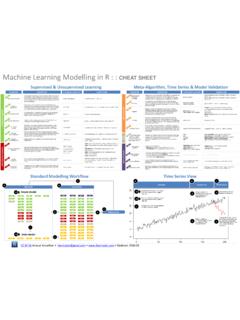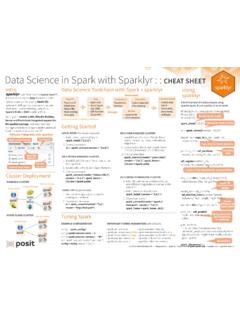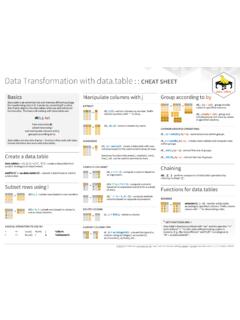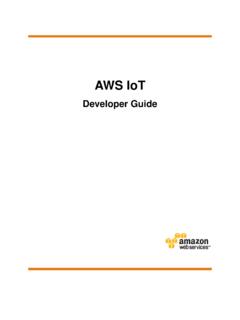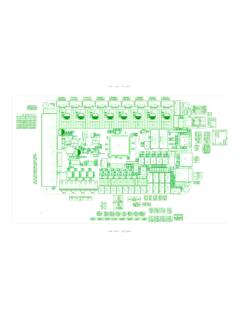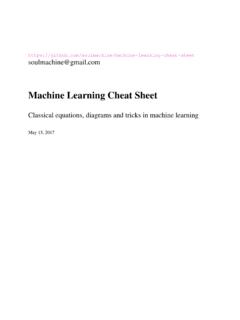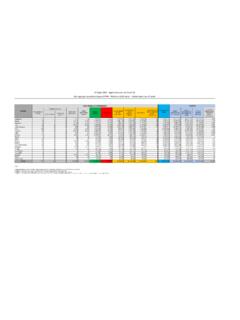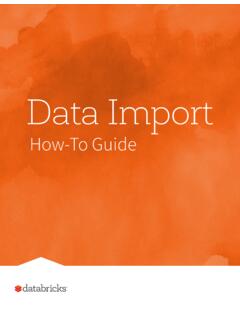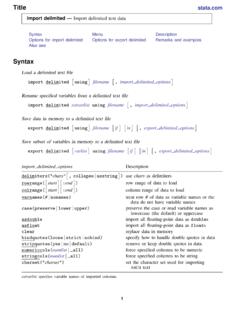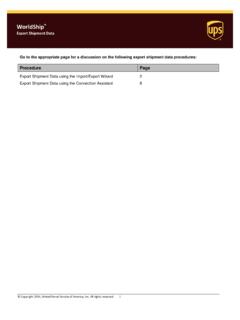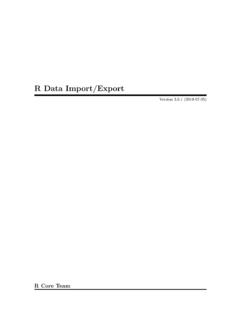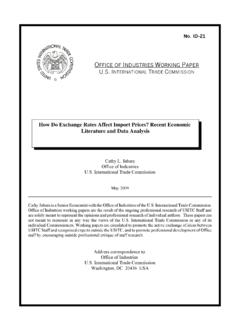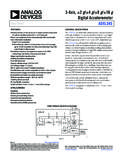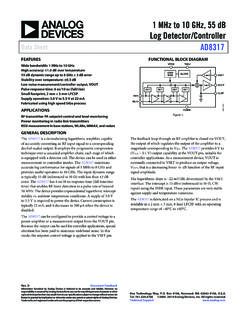Transcription of Data import with the tidyverse : : CHEAT SHEET
1 data import with the tidyverse : : CHEAT SHEET . Read Tabular data with readr read_*(file, col_names = TRUE, col_types = NULL, col_select = NULL, id = NULL, locale, n_max = Inf, One of the first steps of a project is to import OTHER TYPES OF data . skip = 0, na = c("", "NA"), guess_max = min(1000, n_max), show_col_types = TRUE) See ?read_delim outside data into R. data is o en stored in Try one of the following tabular formats, like csv files or spreadsheets. packages to import other types of files: A|B|C. A B C read_delim(" ", delim = "|") Read files with any delimiter. If no The front page of this SHEET shows haven - SPSS, Stata, and SAS files 1 2 3 delimiter is specified, it will automatically guess. how to import and save text files into DBI - databases 1|2|3 4 5 NA To make , run: write_file("A|B|C\n1|2|3\n4|5|NA", file = " ").
2 4|5|NA R using readr. jsonlite - json The back page shows how to import xml2 - XML. A B C read_csv(" ") Read a comma delimited file with period httr - Web APIs A,B,C spreadsheet data from Excel files 1 2 3 decimal marks. rvest - HTML (Web Scraping). 1,2,3 4 5 NA write_file("A,B,C\n1,2,3\n4,5,NA", file = " ") using readxl or Google Sheets using 4,5,NA googlesheets4. readr::read_lines() - text data read_csv2(" ") Read semicolon delimited files with comma Column Specification with readr A B C. A;B;C. 2 3 decimal marks. 1,5;2;3 5 NA write_file("A;B;C\n1,5;2;3\n4,5;5;NA", file = " "). 4,5;5;NA Column specifications define what data type each USEFUL COLUMN ARGUMENTS. column of a file will be imported as. By default A B C read_tsv(" ") Read a tab delimited file. Also read_table().
3 Readr will generate a column spec when a file is Hide col spec message ABC read_*(file, show_col_types = FALSE). 1 2 3 read_fwf(" ", fwf_widths(c(2, 2, NA))) Read a fixed width file. read and output a summary. 123 4 5 NA write_file("A\tB\tC\n1\t2\t3\n4\t5\tNA\n ", file = " "). 4 5 NA spec(x) Extract the full column specification for Select columns to import the given imported data frame. Use names, position, or selection helpers. read_*(file, col_select = c(age, earn)). USEFUL READ ARGUMENTS spec(x). # cols(. A B C No header 1 2 3 Skip lines # age = col_integer(), age is an integer Guess column types 1 2 3 read_csv(" ", col_names = FALSE) 4 5 NA read_csv(" ", skip = 1) # sex = col_character(), 4 5 NA # earn = col_double() To guess a column type, read_ *() looks at the A B C Read a subset of lines # ) first 1000 rows of data .
4 Increase with guess_max. x y z Provide header 1 2 3 read_csv(" ", n_max = 1) sex is a read_*(file, guess_max = Inf). A B C read_csv(" ", earn is a double (numeric) character 1 2 3 col_names = c("x", "y", "z")) A B C Read values as missing 4 5 NA. NA 2 3 read_csv(" ", na = c("1")) COLUMN TYPES DEFINE COLUMN SPECIFICATION. 4 5 NA. Read multiple files into a single table Each column type has a function and Set a default type read_csv(c( , , "), Specify decimal marks corresponding string abbreviation. read_csv(. A;B;C. id = "origin_file") read_delim(" ", locale = file, 1,5;2;3,0 locale(decimal_mark = ",")) col_logical() - "l". col_type = list(.default = col_double()). col_integer() - "i" ). col_double() - "d". Save data with readr col_number() - "n". Use column type or string abbreviation read_csv(.)
5 Col_character() - "c" file, write_*(x, file, na = "NA", append, col_names, quote, escape, eol, num_threads, progress) col_factor(levels, ordered = FALSE) - "f" col_type = list(x = col_double(), y = "l", z = "_"). col_datetime(format = "") - "T" ). A B C write_delim(x, file, delim = " ") Write files with any delimiter. col_date(format = "") - "D" Use a single string of abbreviations A,B,C col_time(format = "") - "t". 1 2 3. write_csv(x, file) Write a comma delimited file. # col types: skip, guess, integer, logical, character 4 5 NA 1,2,3 col_skip() - "-", "_" read_csv(. 4,5,NA write_csv2(x, file) Write a semicolon delimited file. col_guess() - "?" file, col_type = "_?ilc". write_tsv(x, file) Write a tab delimited file. ). RStudio is a trademark of RStudio, PBC CC BY SA RStudio 844-448-1212 Learn more at readr readxl googlesheets4 Updated: 2021-08.
6 Ft import Spreadsheets with readxl with googlesheets4. READ EXCEL FILES READ SHEETS. A B C D E A B C D E. 1 x1 x2 x3 x4 x5 x1 x2 x3 x4 x5 1 x1 x2 x3 x4 x5 x1 x2 x3 x4 x5. 2 x z 8 x NA z 8 NA 2 x z 8 x NA z 8 NA. 3 y 7 9 10 y 7 NA 9 10 READXL COLUMN SPECIFICATION 3 y 7 9 10 y 7 NA 9 10 GOOGLESHEETS4 COLUMN SPECIFICATION. s1 s1. Column specifications define what data type Column specifications define what data type each column of a file will be imported as. each column of a file will be imported as. read_excel(path, SHEET = NULL, range = NULL) read_sheet(ss, SHEET = NULL, range = NULL). Read a .xls or .xlsx file based on the file extension. Read a SHEET from a URL, a SHEET ID, or a dribble Use the col_types argument of read_excel() to Use the col_types argument of read_sheet()/.
7 See front page for more read arguments. Also from the googledrive package. See front page for set the column specification. range_read() to set the column specification. read_xls() and read_xlsx(). more read arguments. Same as range_read(). read_excel(" "). Guess column types Guess column types To guess a column type, read_ excel() looks at SHEETS METADATA To guess a column type read_sheet()/. READ SHEETS the first 1000 rows of data . Increase with the URLs are in the form: range_read() looks at the first 1000 rows of data . guess_max argument. Increase with guess_max. A B C D E read_excel(path, SHEET = read_excel(path, guess_max = Inf) read_sheet(path, guess_max = Inf). NULL) Specify which SHEET SPREADSHEET_ID/edit#gid=SHEET_ID. to read by position or name. Set all columns to same type, character gs4_get(ss) Get spreadsheet meta data .
8 Set all columns to same type, character read_excel(path, SHEET = 1) read_excel(path, col_types = "text") read_sheet(path, col_types = "c"). s1 s2 s3. read_excel(path, SHEET = "s1") gs4_find(..) Get data on all spreadsheet files. Set each column individually sheet_properties(ss) Get a tibble of properties Set each column individually read_excel( for each worksheet. Also sheet_names(). # col types: skip, guess, integer, logical, character excel_sheets(path) Get a vector of SHEET names. path, read_sheets(ss, col_types = "_?ilc"). s1 s2 s3. col_types = c("text", "guess", "guess", numeric") WRITE SHEETS. excel_sheets(" "). ) A B C write_sheet( data , ss =. 1 x 4 1 1 x 4 NULL, SHEET = NULL) COLUMN TYPES. A B C D E To read multiple sheets: 2 y 5 2 2 y 5. Write a data frame into a COLUMN TYPES l n c D L.
9 A B C D E 1. Get a vector of SHEET 3 z 6 3 3 z 6. new or existing SHEET . TRUE 2 hello 1947-01-08 hello s1. names from the file path. logical numeric text date list FALSE world 1956-10-21 1. A B C D E gs4_create(name, .., 2. Set the vector names to TRUE 2 hello 1947-01-08 hello s1 s2 A B C D sheets = NULL) Create a be the SHEET names. FALSE world 1956-10-21 1 skip - "_" or "-" date - "D". 1 new SHEET with a vector s1 s2 3. Use purrr::map_dfr() to guess - "?" datetime - "T". skip logical date 2 of names, a data frame, s1 s2 s3 read multiple files into logical - "l" character - "c". guess numeric list s1 or a (named) list of data one data frame. integer - "i" list-column - "L". text frames. double - "d" cell - "C" Returns path <- " " A B C. sheet_append(ss, data , x1 x2 x3 1 x1 x2 x3 numeric - "n" list of raw cell data .)
10 Path %>% excel_sheets() %>% Use list for columns that include multiple data 2 1 x 4 SHEET = 1) Add rows to 2 y 5. set_names() %>% types. See tidyr and purrr for list-column data . 3 z 6 3 2 y 5 the end of a worksheet. Use list for columns that include multiple data map_dfr(read_excel, path = path) 4 3 z 6 types. See tidyr and purrr for list-column data . s1. OTHER USEFUL EXCEL PACKAGES CELL SPECIFICATION FOR READXL AND GOOGLESHEETS4 FILE LEVEL OPERATIONS. For functions to write data to Excel files, see: Use the range argument of readxl::read_excel() or googlesheets4 also o ers ways to modify other openxlsx googlesheets4::read_sheet() to read a subset of cells from a aspects of Sheets ( freeze rows, set column writexl A B C D E SHEET . width, manage (work)sheets). Go to 1 1 2 3 4 5 2 3 4 read_excel(path, range = "Sheet1!
